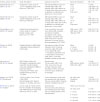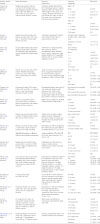Backgrounds
Table 1

| Authors, (years) Country | Study description | Exposure assessment | Exposure categories | RR or HR |
|---|---|---|---|---|
|
Schernhammer et al. (2001) [13] USA |
Prospective cohort study of 121,701 registered nurses, with follow-up 1988–1998 |
Self-reported lifetime years on rotating night shifts, with rotating night shifts defined as “at least three nights per month, in addition to evenings and afternoons in that month” |
Never 1–15 15–29 ≥ 30 P for trend |
1.0 (ref) 1.08 (0.99–1.18) 1.08 (0.90–1.30) 1.36 (1.0–1.78) 0.02 |
|
Schernhammer et al. (2006) [14] USA |
Prospective cohort study of 116,087 registered nurses, with follow-up 1989–2001 |
Self-reported lifetime years on rotating night shifts, with rotating night shifts defined as “at least three nights per month, in addition to evenings and afternoons in that month” |
Never 1–9 10–19 20+ P for trend |
1.0 0.98 (0.87–1.10) 0.91 (0.72–1.16) 1.79 (1.06–3.01) 0.65 |
|
Schwartzbaum et al. (2007) [15] Sweden |
Register-based retrospective cohort study of 1,148,661 female workers, with follow-up 1971–1989 |
Usual occupation and work hours (three-shift schedules and others) to define occupations with a large proportion of workers with night work; from in-person interviews in annual surveys of living conditions (1977–1981) |
Shift work in 1970 Shift work in both 1960 and 1970 |
0.94 (0.74–1.18) 0.97 (0.67–1.40) |
| Pronk et al. (2010) [18] China | Shanghai Women's Health Study: a population-based prospective cohort study |
Job exposure matrix of three categories with increasing scores for night-shift work: 0 = no night-shift work; 1 = incidental night-shift work; 2 = jobs likely to involve the night shift, 3 = jobs that probably involved all-night shifts |
Never 1–5 years 6–17 years 18 years and more |
1.0 (ref) 0.9 (0.6–1.3) 0.9 (0.6–1.4) 0.8 (0.5–1.2) |
|
Knutsson et al. (2012) [16] Sweden |
WOLF (Work, Lipids, and Fibrinogen) occupational cohort study that included subjects who were employed in different public and private companies (N = 4036), with average follow-up time of 12.4 years |
Questionnaire: “Do you work shifts?” and “How many hours do you normally work per week, including overtime, and how are these hours distributed on average?” |
Day Shifts without nights Shifts with nights |
1.0 (ref) 1.23 (0.70–2.17) 2.02 (1.03–3.95) |
| Koppes et al. (2014) [19] Netherlands |
14 Dutch Labor Force Surveys (1996–2009) Record linkage with national registers on hospital admission |
Current exposure to night work was assessed with the question: “Do you work at nights, meaning between midnight and 6 am?” |
No night work Occasional Regular |
1.0 (ref) 1.04 (0.85–1.27) 0.87 (0.72–1.05) |
| Åkersted et al. (2015) [17] Sweden |
Cohort study of 13,656 women from the Swedish Twin Registry, with 3404 exposed to night work; follow-up time of 12 years |
Questionnaire: “For how many years have you had working hours that meant that you worked nights at least now and then?” |
Follow-up to 60 years | |
| No night work | 1.0 (ref) | |||
| 1–5 years | 0.93 (0.66 to 1.31) | |||
| 6–10 years | 0.79 (0.45 to 1.38) | |||
| 11–20 years | 0.80 (0.45 to 1.42) | |||
| 21–45 years | 1.77 (1.03 to 3.04) |
Table 2

|
Authors, (years) Country |
Study description |
Exposure Assessment |
Exposure categories |
Odds ratio |
|---|---|---|---|---|
|
Tynes et al. (1996) [27] Norway |
Nested case-control study of a cohort of 2619 female radio and telegraph operators enrolled 1920–1980, with follow-up 1961–1991; 50 cases and 4–7 matched (year of birth) controls | Collected detailed job histories from Norwegian seamen registry; “Work at night with exposure to artificial light?” From cases and controls, detailed information on job histories on ships, as well as shift work and travel through time zones was collected | Aged < 50 | |
| None | 1.0 (ref) | |||
| < 3.1 years. | 0.3 (0.1–1.2) | |||
| > 3.1 years | 0.9 (0.3–2.9) | |||
| P for trend | 0.97 | |||
| Aged 50+ | ||||
| None | 1.0 (ref) | |||
| < 3.1 years | 3.2 (0.6–17.3) | |||
| > 3.1 years | 4.3 (0.7–26.0) | |||
| P for trend | 0.13 | |||
|
Hansen (2001) [20] Denmark |
Nested case-control study with follow-up 1964–1999; 7565 cases and 1:1 matched controls (year of birth and sex) |
Individual employment histories were obtained from files of national pension funds | All night work combined in trades with > 60% night work | 1.5 (1.3–1.7) |
| Employed > 6 years | 1.7 (1.3–1.7) | |||
| Nurses | 1.3 (1.1–1.4) | |||
|
Davis et al. (2001) [21] USA |
Cancer register-based case–control study; 813 cases (1992–1995) and 793 matched (5-year age groups) controls identified by random-digit dialing | Information on sleeping habits, light exposure, lifetime occupational history obtained from in-person interviews; night workers defined if ≥1 graveyard shift/wk. (8 h) in 10 years before diagnosis of cancer |
Years worked
≥ 3 nights/wk. |
|
| None | 1.0 (ref) | |||
| < 1 | 1.2 (0.6–2.3) | |||
| 1–3 | 1.4 (0.7–2.8) | |||
| 3–4.6 | 0.6 (0.3–1.5) | |||
| 4.7+ | 2.3 (1.2–4.2) | |||
| P for trend | 0.01 | |||
|
Lie et al. (2006) [22] Norway |
Nested case-control study of the cohort of 44,835 Norwegian nurses; 537 cases (1960–1982) and 1:4 matched (year of birth) controls | Total work history reconstructed from occupational information for nurses from the registry censuses of the Norwegian Board of Health in 1960, 1970, and 1980 | Years night work | |
| 0 | 1.0 (ref) | |||
| 1–14 | 0.95 (0.67–1.33) | |||
| 15–29 | 1.29 (0.82–2.02) | |||
| 30+ | 2.21 (1.10–4.45) | |||
| P for trend | 0.01 | |||
|
O'Leary et al. (2006) [29] USA |
Case-control study of 576 cases (1996–1997) and 585 1:1 matched (age in 5-year age groups) population-based controls | Occupational history since age 16, and residential light-at-night exposures (e.g., sleep hours, frequency of turning on lights during night, length of time light was on) from in-person interviews | Any evening or overnight shift work | 1.04 (0.79–1.38) |
| Any evening shift work only | 1.21 (0.90–1.64) | |||
| Any overnight shift work only | 0.55 (0.32–0.94) | |||
|
Pesch et al. (2010) [30] Germany |
GENICA: a population-based case-control study conducted among women from the Greater Region of Bonn, Germany | Night work was defined as working full-time between 24.00–05.00 h | Never | 1.0 (ref) |
| 1–4 years | 0.64 (0.34–1.24) | |||
| 5–9 years | 0.93 (0.41–2.15) | |||
| 10–19 years | 0.91 (0.38–2.18) | |||
| 20 years and more | 2.49 (0.87–7.18) | |||
|
Lie et al. (2011) [26] Norway |
Nested case-control study within a cohort of 49,402 female nurses; 699 cases and 895 controls |
“Night work” includes working periods in both rotating and permanent night schedules, and includes the work of permanent night workers |
Never night work | 1.0 (ref) |
| 1–11 years | 1.2 (0.9–1.5) | |||
| 12 years | 1.3 (0.9–1.8) | |||
| P for trend | 0.17 | |||
|
Hansen et al. (2012) [23] Denmark |
Nested case-control study within a nationwide cohort of Danish nurses (N = 91,140), including detailed information on lifetime shift-work and potential confounders | Information on shift work obtained from interviews; Day work defined as working from 6 or 7 to 15 or 16, evening work from 15 or 16 to 23 or 24, and night work from 23 or 24 to 7 or 8 | Day-evening only | 1.0 (ref) |
| 1–4 years of night work | 1.5 (0.99–2.5) | |||
| 5–9 | 2.3 (1.4–3.5) | |||
| 10–19 | 1.9 (1.1–2.8) | |||
| ≥ 20 | 2.1 (1.3–3.2) | |||
|
Hansen et al. (2012) [24] Denmark |
Nationwide case-control study nested within a cohort of 18,551 female military employees born in 1929–1968 |
Information on shift work, sun exposure habits, diurnal preferences, and other potential confounders | Never | 1.0 (ref) |
| 1–5.9 years | 0.9 (0.4–1.7) | |||
| 6–14.9 years | 1.7 (0.9–3.2) | |||
| 15 years and more | 2.1 (1.0–4.5) | |||
| P for trend | 0.06 | |||
|
Fritschi et al. (2013) [28] Australia |
Case control study of cases from the population-based Western Australian (WA) Cancer Registry, with 1205 incident cases and 1789 frequency age-matched controls |
Information on shift work obtained from telephone interviews, with levels of night work being high: job involved > 4 nights forward rotation or > 6 nights backward rotation, medium: 3–4 nights forward or 4–6 nights backward rotation, or low: 3 nights backward rotation |
No rotation Ever < 10 years 10–20 years > 20 years |
1.0 (ref) 1.16 (0.97–1.38) 1.25 (1.00–1.56) 1.09 (0.79–1.50) 1.02 (0.71–1.45) |
|
Grundy et al. (2013) [25] Canada |
A case-control study from 2005 to 2010 |
Case definition: where ≥50% of time was reported to have been spent on evening and/or night shifts, capturing both rotating and permanent night shift schedules | No shifts | 1.0 (ref) |
| 0–14 years | 0.95 (0.79–1.16) | |||
| 15–29 years | 0.93 (0.67–1.30) | |||
| > 30 years | 2.21 (1.14–4.31) | |||
|
Menegaux et al. (2013) [31] France |
Population-based case-control study with 1232 cases of breast cancer and 1317 population controls |
Information on shift work obtained from in-person interviews; Overnight: night shift of 6 consecutive work hours or more spanning the time period 11 pm–5 am |
Never | 1.0 (ref) |
| < 4.5 years | 1.27 (0.83–1.94) | |||
| 4.5 years and more | 1.40 (0.96–2.04) | |||
|
Li et al. (2015) [32] China |
An extension of a series of case-cohort studies of textile industry exposures to dusts, chemicals, and other physical agents in relation to risks of various cancers | Night work was defined as continuous work between 24:00 and 05:00 | Day workers | 1.0 (ref) |
| 3 times/month | 1.4 (0.8–2.6) | |||
| 1–14 years | 1.2 (0.9–1.6) | |||
| 15–29 years | 1.2 (0.9–1.7) | |||
| > 30 years | 0.8 (0.5–1.4) | |||
|
Papantoniou et al. (2015) [33] Spain |
Population-based case-control study with 1708 breast cancer cases and 1778 population controls from 10 Spanish regions | Lifetime occupational history was assessed by face-to-face interviews | Never night work | 1 (ref) |
| Ever night work | 1.18 (0.97, 1.43) | |||
| Permanent | 1.19 (0.89, 1.60) | |||
| Rotating | 1.17 (0.91, 1.51) |
Table 3

| Authors (years) | Overall OR or RR (95% CI) | Night work exposure category |
|---|---|---|
| Megdal et al. (2005) [34] | 1.51 (1.36–1.68) | Ever |
| Jia et al. (2013) [35] | 1.20 (1.08–1.33) | Ever |
| 1.15 (1.03–1.29) | ≥ 15 years | |
| Kamdar et al. (2013) [36] | 1.21 (1.00–1.47) | Ever |
| 1.04 (0.92–1.18) | ≥ 8 years | |
| Wang et al. (2013) [37] | 1.19 (1.05–1.35) | Ever |
| 1.03 (1.01–1.05) | Every 5 years of exposure increased | |
| Ijaz et al. (2013) [38] | 1.05 (1.01–1.10) | Every 5 years of exposure increased |
| Travis et al. (2016) [39] | 0.99 (0.95–1.03) | Ever |
| 1.01 (0.93–1.10) | ≥ 20 years | |
| 1.00 (0.87–1.14) | ≥ 30 years |




 PDF
PDF Citation
Citation Print
Print



 XML Download
XML Download